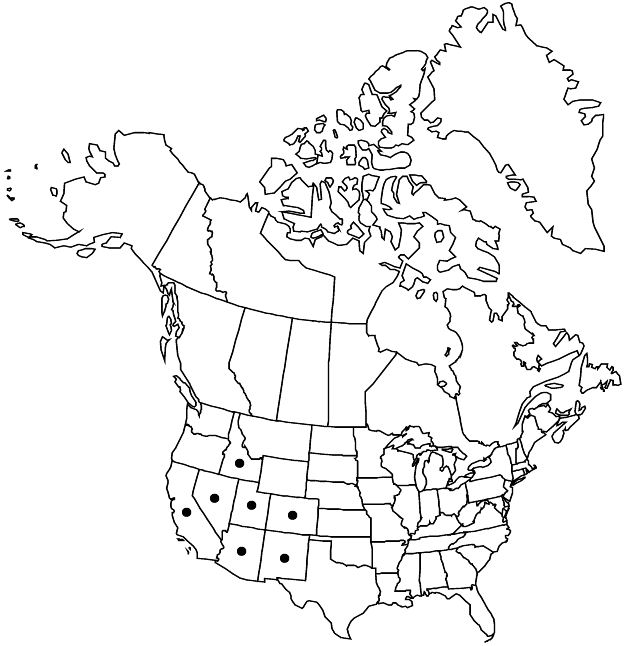Difference between revisions of "Purshia stansburyana"
Phytologia 60: 468. 1986.
FNA>Volume Importer |
imported>Volume Importer |
||
| (5 intermediate revisions by 2 users not shown) | |||
| Line 8: | Line 8: | ||
}} | }} | ||
|common_names=Cliffrose | |common_names=Cliffrose | ||
| − | |basionyms={{Treatment/ID/ | + | |basionyms={{Treatment/ID/Basionym |
|name=Cowania stansburyana | |name=Cowania stansburyana | ||
|authority=Torrey | |authority=Torrey | ||
| + | |rank=species | ||
| + | |publication_title=in H. Stansbury, Exped. Great Salt Lake, | ||
| + | |publication_place=386, plate 3. 1852 (as stansburiana) | ||
}} | }} | ||
|synonyms={{Treatment/ID/Synonym | |synonyms={{Treatment/ID/Synonym | ||
|name=C. mexicana var. stansburyana | |name=C. mexicana var. stansburyana | ||
|authority=(Torrey) Jepson | |authority=(Torrey) Jepson | ||
| + | |rank=variety | ||
}} {{Treatment/ID/Synonym | }} {{Treatment/ID/Synonym | ||
|name=Purshia mexicana var. stansburyana | |name=Purshia mexicana var. stansburyana | ||
|authority=(Torrey) S. L. Welsh | |authority=(Torrey) S. L. Welsh | ||
| + | |rank=variety | ||
}} | }} | ||
|hierarchy=Rosaceae;Rosaceae subfam. Dryadoideae;Rosaceae tribe Dryadeae;Purshia;Purshia stansburyana | |hierarchy=Rosaceae;Rosaceae subfam. Dryadoideae;Rosaceae tribe Dryadeae;Purshia;Purshia stansburyana | ||
| Line 43: | Line 48: | ||
-->{{#Taxon: | -->{{#Taxon: | ||
name=Purshia stansburyana | name=Purshia stansburyana | ||
| − | |||
|authority=(Torrey) Henrickson | |authority=(Torrey) Henrickson | ||
|rank=species | |rank=species | ||
| Line 58: | Line 62: | ||
|publication year=1986 | |publication year=1986 | ||
|special status= | |special status= | ||
| − | |source xml=https:// | + | |source xml=https://bitbucket.org/aafc-mbb/fna-data-curation/src/2e0870ddd59836b60bcf96646a41e87ea5a5943a/coarse_grained_fna_xml/V9/V9_560.xml |
|subfamily=Rosaceae subfam. Dryadoideae | |subfamily=Rosaceae subfam. Dryadoideae | ||
|tribe=Rosaceae tribe Dryadeae | |tribe=Rosaceae tribe Dryadeae | ||
Latest revision as of 22:57, 5 November 2020
Shrubs, evergreen, 10–40(–75) dm. Stems: young-stem internodes 5–14 mm, sparsely hirtellous or glabrous, usually stipitate-glandular; short-shoot spurs simple or branched, 10–20(–40) × 1.2–2.7 mm. Leaves: blade dark green adaxially, obovate, (3–)7–12(–19) × (2–)3–8(–13) mm, irregularly lobed in distal 1/2, lobes (3–)5(–7), proximal 2 lobes ascending, oblong to spatulate, narrow, 2–6 mm, distal 3 lobes deflexed, reduced, margins strongly revolute, usually entire, rarely toothed proximally, apex rounded to truncate, abaxial surface white-villous, midvein greenish, glabrate, glandular-punctate, adaxial sparsely hirtellous or arachnoid villous, soon glabrate, ± glandular-punctate. Pedicels 2.5–4.5 mm. Flowers: hypanthium obconic, 4–6.5 × 1.5–3 mm, 3–5 mm diam. in fruit, arachnoid-villous to pubescent, usually stipitate-glandular; petals light to cream-yellow or -white, broadly obovate, 7–13(–15) mm; stamens (52–)60–90(–125); carpels (3–)4–7(–10). Achenes oblanceoloid, 6–8 × 1.8–2.2 mm, 12-ribbed, persistent style 35–59 mm, plumose hairs 1.4–2.2 mm. 2n = 18.
Phenology: Flowering Apr–May(–Oct).
Habitat: Pinyon-juniper, Joshua tree, yellow pine woodlands, arid desert scrub, desert chaparral
Elevation: (1000–)1200–2200(–2600 m)
Distribution

Ariz., Calif., Colo., Idaho, Nev., N.Mex., Utah, Mexico (Baja California, Sonora).
Discussion
Purshia stansburyana is vegetatively similar to P. tridentata var. glandulosa, the latter usually having thicker leaves with narrower abaxial grooves and apiculate apices. The two sometimes can only be distinguished by flowers or fruits.
Purshia stansburyana forms hybrids with P. tridentata vars. glandulosa and tridentata. The hybrids easily can be recognized by their 2–3(–5) carpels and achenes with styles 12–28 mm, among other characteristics (H. C. Stutz and L. K. Thomas 1963). Hybrids between P. stansburyana and P. tridentata var. glandulosa have been given the names Cowania mexicana var. dubia Brandegee and C. alba Goodding. Introgression with P. stansburyana occurs in two populations of P. subintegra.
Selected References
None.